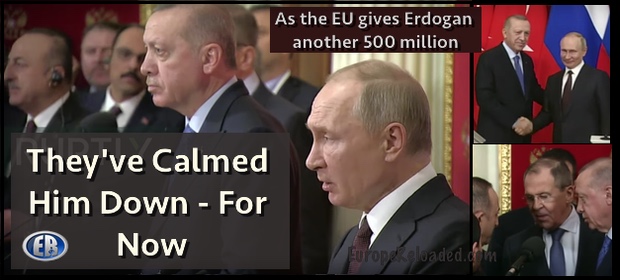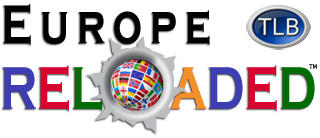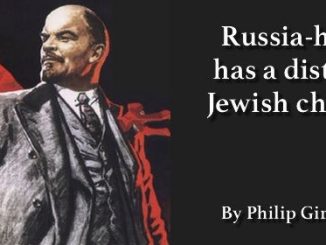
Pam Barker | Director of TLB Europe Reloaded Project
Two things of note: first, yesterday’s six-hour meeting between Erdogan and Putin in Moscow. Which seemed to go well, and has produced, for now, a ceasefire and a mere 6km buffer zone. See Sputnik‘s Fighting in  Syria’s Idlib Stops Following Turkey-Russia Ceasefire Deal – Source.
Syria’s Idlib Stops Following Turkey-Russia Ceasefire Deal – Source.
Second, the migrants – thousands of them – encouraged to gather at the Greek and Bulgarian borders with Turkey. In the featured piece below by Pepe Escobar, Greece doesn’t have the military capability to stop this mass influx, despite the huffing and puffing from Greek PM Kyriakos Mitsokas earlier this week on a visit to the border areas with Turkey by Ursula von der Leyen and Charles Michel. What to do? It seems that the EU has hastily thrown another tranche of cash at Erdogan to placate him.
See this FreeWest Media piece, from AFP yesterday, titled EU hands over another €500 million to Turkey to stop migrants. Of note:
The European Commission is preparing new, additional aid of 500 million euros for “Syrian refugees” in Turkey and several other measures to ease tensions with Ankara. Only 4 percent of migrants currently trying to enter the EU are from Syria while 64 percent are from Afghanistan.
The AFP learned on Thursday that the funding of 500 million euros will complement the 6 billion allocated under the agreement concluded in 2016 to finance programs implemented by NGOs for the approximately 3.7 million Syrian refugees in Turkey, explained a source.
The executive chaired by German Ursula von der Leyen also proposed to facilitate the issuance of visas for Turkish nationals.
European Foreign Minister Josep Borrell announced on Wednesday the release of 170 million euros in emergency aid “for the most vulnerable in Syria” during his trip to Ankara.
So Erdogan Khan has been calmed down for now. But commentators don’t expect this to last for very long, and Moscow’s at the end of its rope with him.
Below, Pepe Escobar (in a piece originally titled Empires of the Steppes Fuel Erdogan Khan’s Dreams) explains why, for historical reasons, Erdogan would indeed be a Khan, at least in his own mind, and why this kind of tribal, warlike behaviour has form in this part of the world. And how, supreme irony of ironies, it is in fact Russia that is preventing the migrant flooding of Europe.
Here’s the RT video of yesterday’s post-meeting media address in Moscow:
See also the Duran team’s take on this, which Alexander Mercouris estimates is a success for both Syria and Russia – to dictate a settlement to Erdogan without humiliating him:
********
Turkey’s Muslim Invasion of Europe Is Being Prevented by, Who Else? – Russia
PEPE ESCOBAR
The latest installment of the interminable Syria tragedy could be interpreted as Greece barely blocking a European “invasion” by Syrian refugees. The invasion was threatened by President Erdogan even as he refused the EU’s puny “offer you can refuse” bribe of only one billion euros.
 Well, it’s more complicated than that. What Erdogan is in fact weaponizing is mostly economic migrants – from Afghanistan to the Sahel (see map) – and not Syrian refugees.
Well, it’s more complicated than that. What Erdogan is in fact weaponizing is mostly economic migrants – from Afghanistan to the Sahel (see map) – and not Syrian refugees.
Informed observers in Brussels know that interlocking mafias – Iraqi, Afghan, Egyptian, Tunisian, Moroccan – have been active for quite a long time smuggling everyone and his neighbor from the Sahel via Turkey, as the Greek route towards the EU Holy Grail is much safer than the Central Mediterranean.

The EU sending a last-minute emissary to Ankara will yield no new facts on the ground – even as some in Brussels, in bad faith, continue to carp that the one million “refugees” trying to leave Idlib could double and that, if Turkey does not open its borders with Syria, there will be a “massacre.”
Those in Brussels spinning the “Turkey as victim” scenario list three conditions for a possible solution. The first is a ceasefire – which in fact already exists, via the Sochi agreement, and was not respected by Ankara. The second is a “political process” – which, once again, does exist: the Astana process involving Russia, Turkey and Iran. And the third is “humanitarian aid” – a euphemism that means, in fact, a NATO intervention – of the Libya “humanitarian imperialism” kind.
As it stands, two facts are inescapable. Number one: the Greek military don’t have what it takes to resist, in practice, Ankara’s weaponizing of the so-called “refugees.”
Number two is the kind of stuff that makes NATO fanatics recoil in horror: Since the Ottoman siege of Vienna, this is the first time in four centuries that a “Muslim invasion” of Europe is being prevented by, who else, Russia.
Fed up with the sultan
This past Sunday, Ankara launched yet another Pentagon-style military adventure, baptized as Spring Shield. All decisions are centralized by a triumvirate: Erdogan, Defense Minister Hulusi Akar and the head of MIT (Turkish intel) Hakan Fidan. John Helmer has memorably called them the SUV (Sultan and the Ugly Viziers).

Behlul Ozkan, from the University of Marmara, a respected Kemalist scholar, frames the whole tragedy as having been played since the 1980s, now back on the stage on a much larger scale since the start of the so-called Syrian chapter of the Arab Spring in 2011.
Ozkan charges Erdogan with creating “conquering troops out of five unlikely fundamentalist groups” and “naming the armed groups after Ottoman sultans,” claiming they are a sort of national salvation army. But this time, argues Ozkan, the results are much worse – from millions of refugees to the terrible destruction in Syria, and “the emergence of our political and military structures affecting national security in a dangerous way.”
To say that the Russian General Staff are absolutely fed up with the SUV’s shenanigans is the ultimate understatement. That’s the background for the meeting this Thursday (ER: yesterday, March 5) in Moscow between Putin and Erdogan. Methodically, the Russians are disrupting Turk operations to an unsustainable level – ranging from renewed air cover to the Syrian Arab Army, to electronic countermeasures totally smashing all Turkish drones.
Russian diplomatic sources confirm that no one in Moscow believes any word, promise or cajoling emanating from Erdogan anymore. So it’s useless to ask him to respect the Sochi agreement. Imagine a Sun Tzu-style meeting, with the Russian side displaying the very picture of self-restraint while scrutinizing Erdogan on how much he is willing to suffer before desisting from his Idlib adventure.
Those non-nonsense proto-Mongols
What ghosts from the past have evolved in Erdogan’s unconscious? Let history be our guide – and let’s go for a ride among the empires of the steppes.
In the 5th century, the Juan Juan people, proto-Mongols as much as their cousins the White Huns (who lived in today’s Afghanistan), were the first to give their princes the title of khan – afterwards used by the Turks as well as the Mongols.
A vast Eurasian Turco-Mongol linguistic spectrum – studied in detail by crack French experts such as J.P. Roux – evolved via conquering migrations, more or less ephemeral imperial states, and aggregating diverse ethnic groups around rival Turkish or Mongol dynasties. We can talk about an Eurasian Turk space from Central Asia to the Mediterranean for no less than a millennium and a half – but only, crucially, for 900 years in Asia Minor (today’s Anatolia).
These were highly hierarchical and militarized societies, unstable, but still capable, given the right conditions such as the emergence of a charismatic personality, to engage in a strong collective project of building political constructions. So the charismatic Erdogan Khan mindset is not much different from what happened centuries ago.
The first form of this socio-cultural tradition appeared even before the conversion to Islam – which happened after the battle of Talas in 751, won by the Arabs against the Chinese. But most of all, it all crystallized around Central Asia from the 10th and 11th centuries onwards.
Unlike Greece in the Aegean, unlike India or Han China, there was never a central focus in terms of a cultural berth or supreme identity organizing this process. Today, this role in Turkey is played by Anatolia – but that’s a 20th century phenomenon.
What history has shown is an east-west Eurasian axis across the steppes, from Central Asia to Anatolia, through which nomad tribes, Turk and Turkmen, then the Ottoman Turks, migrated and progressed, as conquerors, between the 7th and the 17th centuries: a whole millennium building an array of sultanates, emirates and empires. No wonder the Turkish president pictures himself as Erdogan Khan or Sultan Erdogan.
“Idlib is mine”

So there is a link between the turcophone tribes of Central Asia from the 5th and 6th centuries and the current Turkish nation. From the 6th to the 11th centuries, they were set up as a confederation of big tribes. Then, going southwest, they founded states. Chinese sources document the first turkut (Turkish empires) as eastern Turks in Mongolia and western Turks in Turkestan.
They were followed by more or less ephemeral empires of the steppes such as the Uighurs in the 8th century (who, by the way, were originally Buddhists). It’s interesting that this original past of the Turks in Central Asia, before Islam, was somewhat elevated to mythic status by the Kemalists.
This universe was always enriched by outside elements – such as Arab-Persian Islam and its institutions inherited from the Sassanids, as well as the Byzantine empire, whose structural elements were adapted by the Ottomans. The end of the Ottoman empire and multiple convulsions (the Balkan wars, WWI, the Greek-Turkish war) ended up with a Turkish nation-state whose sanctuary is Asia Minor (or Anatolia) and eastern Thrace, conformed into a national territory that’s exclusively Turk and denies every minority presence that is non-Sunni and non-turcophone.
Evidently that’s not enough for Erdogan Khan.
Even Hatay province, which joined Turkey in 1939, is not enough. Home to the historic Antioch and Alexandretta, Hatay was then re-baptized as Antakya and Iskenderun.
Under the Treaty of Lausanne, Hatay was included in the French mandate of Syria and Lebanon. The Turkish version is that Hatay declared its independence in 1938 – when Ataturk was still alive – and then decided to join Turkey. The Syrian version is that Hatay was acquired via a rigged referendum ordered by France to bypass the Treaty of Lausanne.
Erdogan Khan has proclaimed “Idlib is mine.” Syria and Russia are responding, “No, it’s not.”
Those were the days, when turcophone empires of the steppes could just advance and capture their prey.
************
Original article (taken from Russia Today but also available at Unz Review)

••••
The Liberty Beacon Project is now expanding at a near exponential rate, and for this we are grateful and excited! But we must also be practical. For 7 years we have not asked for any donations, and have built this project with our own funds as we grew. We are now experiencing ever increasing growing pains due to the large number of websites and projects we represent. So we have just installed donation buttons on our websites and ask that you consider this when you visit them. Nothing is too small. We thank you for all your support and your considerations … (TLB)
••••
Comment Policy: As a privately owned web site, we reserve the right to remove comments that contain spam, advertising, vulgarity, threats of violence, racism, or personal/abusive attacks on other users. This also applies to trolling, the use of more than one alias, or just intentional mischief. Enforcement of this policy is at the discretion of this websites administrators. Repeat offenders may be blocked or permanently banned without prior warning.
••••
Disclaimer: TLB websites contain copyrighted material the use of which has not always been specifically authorized by the copyright owner. We are making such material available to our readers under the provisions of “fair use” in an effort to advance a better understanding of political, health, economic and social issues. The material on this site is distributed without profit to those who have expressed a prior interest in receiving it for research and educational purposes. If you wish to use copyrighted material for purposes other than “fair use” you must request permission from the copyright owner.
••••
Disclaimer: The information and opinions shared are for informational purposes only including, but not limited to, text, graphics, images and other material are not intended as medical advice or instruction. Nothing mentioned is intended to be a substitute for professional medical advice, diagnosis or treatment.




